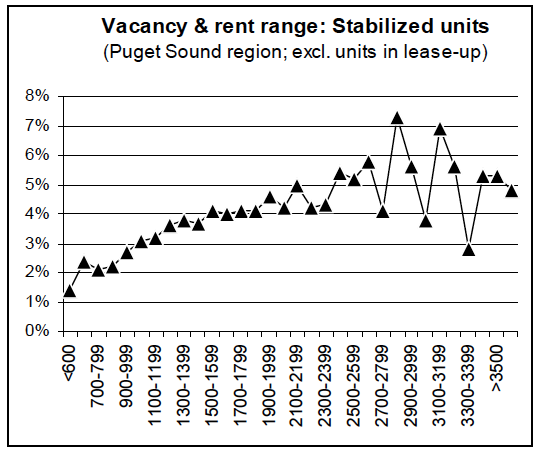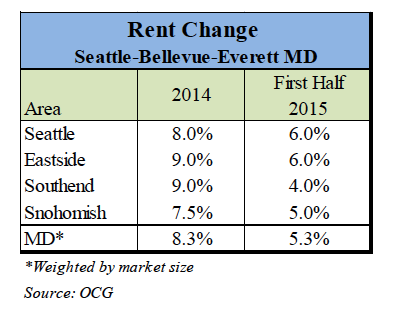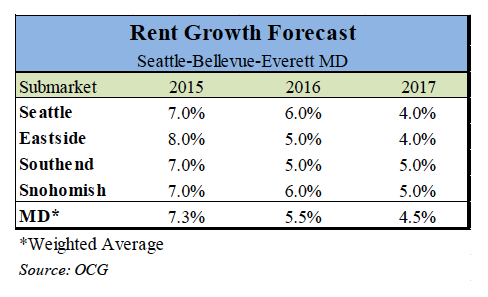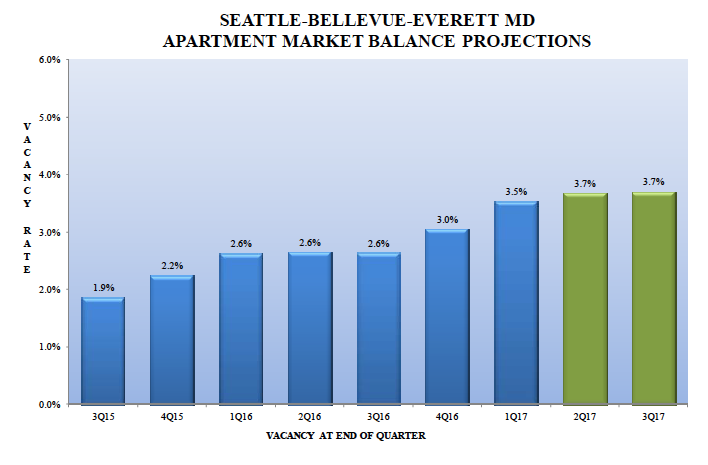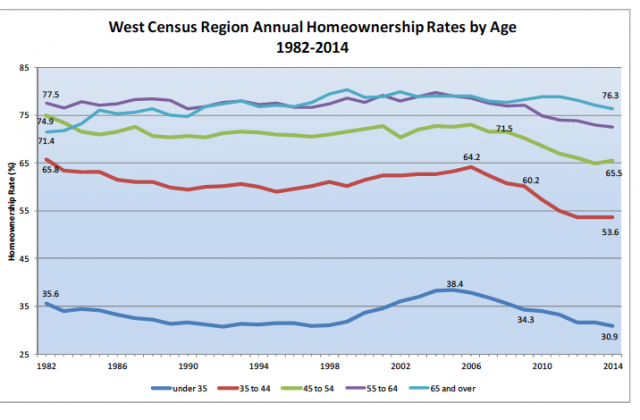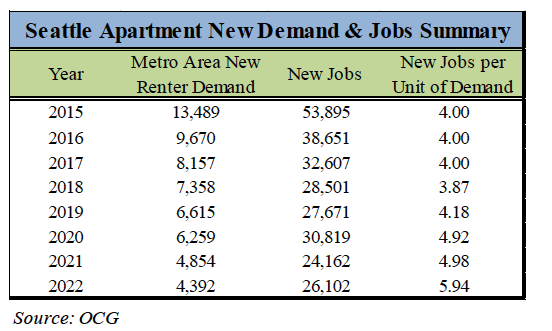Storm of the Century?: City Planners Blow the Housing Forecast and Microhousing
Apartment guru Mike Scott of Dupree + Scott has just released their latest Apartment Advisor newsletter and it is packed with lots of great data. I won’t go through his clarion explanation of supply and demand and vacancy rates (Surprise! Lower vacancy rates mean higher rents), or his discussion of the fact that rent increases aren’t keeping up with inflation since we’ve talked about these again, and again. But I want to walk through a key point about Scott’s professional view about prices and how they relate to affordability and microhousing. Scott says,
20 percent of the units in the region rent for $1,000 or less. That makes all of those units affordable to households earning at least $3,000 a month. That’s if affordability should be calculated based incomes being three times the rent.
We’re just using that amount as an example. But not everyone pays one-third of their income on rent. Some pay more. Some pay less. That means that although some households can afford to spend more than $1,000 a month, they choose to be frugal and rent an apartment for less than that.
Here Scott is starting at the same point of departure as the City when it looks at the housing issue purely as a question of how many households are paying exactly 30 percent of their income on housing; based on the way the City views the “problem,” if your household pays more, you’re cost burdened, and less, you’re camped out in an apartment that should go to someone with less income, something called “downrenting.” How many households are “cost burdened” or “downrenting?”
Greg Willett, the Chief Economist at RealPage, also spoke at WMFHA’s Washington Apartment Outlook and commented that his company did an extensive nationwide analysis of leases and found that the typical renter household spent 23% of income on rent.
We decided to do a small survey locally to see if things are different here. It was a very quick and small survey, but we found the median rent payment was 24% of income at the time of the initial lease. Only one-third of the households spent more than 30%.
We caution that this was a small survey. A more comprehensive survey will likely change the numbers. However, it still will show that a significant number of households spend less than 30% of their income on rent. That’s commendable and it should not be discouraged (emphasis is mine).
I’ve asked, mostly in a snarky way because I know they won’t answer, whether the City’s view is that if everyone paid exactly 30 percent of their monthly income on housing, would we still have a housing crisis? Of course, the answer is, “Yes,” since the only measure of the “crisis” the City bureaucrats use is exactly that, the deeply flawed Housing Cost Income Ratio model that has been with us for years and needs to be examined and changed.
We’ve pointed out before, that problems with paying rent aren’t necessarily a function of “skyrocketing rents,” but of people not having enough income to cover the costs of housing — or much of anything else. In other words, pointing out that poor people pay more of their income for housing is obvious, but blames the realities of the housing market only without looking at the broader issues of income and rising expenses for other important things.
So what are the implications of this data?
First, those households spending less than 30% of their income on rent are consuming housing that would be barely affordable for other renters. That means that however you measure the number of units that are affordable at any particular income level, some of them are occupied by households making more than that. So, you’d think that whatever developers can do to add lower cost units would be encouraged . . .
Scott goes on and points out, that
Second, it means that some renters, if not quite a few, can afford to pay more rent than they are paying now. Of course that’s just based on our simple one-third of income formula. Maybe they have the same problem U2 pointed out on their Joshua Tree album, singing, “I still haven’t found what I’m looking for.” That suggests there is room for them to move up into more expensive housing, if developers create the right kind of product and amenities in the right locations. Given how quickly new construction has been leasing up, and the high occupancy rate in these units, that may be happening now.
Again, the obvious thing to do would be to build more housing. Scott talks about the kind of housing that should be encouraged, and it’s no surprise that what would help prices would be more market rate housing that allows those people paying less but that can and might want to pay more, move to newer, more expensive units thus freeing up their unit for someone with less money.
We’re guessing that if you own a property with those lower cost, more affordable rents, you’re wondering about now why we would encourage more construction in your rent range to compete with you. Well, the simple answer is, you can handle it. Look at the Vacancy & rent range: Stabilized units chart on page 7. That’s the middle one. It shows that units renting for $1,200 a month or less don’t have a lot of vacancies.
So taken together, building new, more expensive apartment units would create a “moving on up” opportunity for some who are “down renting” and building more microhousing and Small Efficiency Dwelling Units (SEDUs) would also meet the need for the really hard to find apartments at $1200 or less. But, Scott points out,
The problem is how can developers deliver new units in that price range?
Actually, they have been doing just that with congregate housing and were ready to do more of it until Seattle balked. Ironically, as Seattle backed away from this simple affordable housing option, other cities like Tacoma, Redmond, Kirkland, and likely more to come are stepping in and embracing the concept of smaller living spaces. Their solutions are less dramatic than what Seattle developers were doing, but their problems are less dramatic as well. The point is they are jumping in while Seattle backs out.
The City is doing exactly the opposite of what Scott sees when he looks at the same data and the same measures the City uses: they are adding rules, regulations, and costs through Mandatory Inclusionary Zoning (MIZ) to new construction and eliminating the one option that would add more supply at lower price levels, microhousing. I haven’t seen a more clear example of the complete disconnect City planners and politicians have with reality and real time price and supply data. It’s all right there: build more housing of all kinds everywhere and the demand will sustain it. Instead, we’re slowing supply of regular market rate apartment units and killing off smaller, less expensive units.
Good work. Maybe the City planners should go into the weather forecasting business.
O’Brien: No to Small-Lot, Micros, Low-Rise, but YES! to Tents?
Seattle is in the grip of a panic over homeless encampments. Who’s panicking? The same people that have panicked over small-lot housing in single-family zones, that panicked over microhousing, and that panicked over buildings in the low-rise zone blocking precious light and air. These are also the people who Councilmember Mike O’Brien has been listening to since he arrived at the City Council in 2010. His first capitulation to the NIMBY mob was a long time ago, in 2010, when he opposed a well-studied suggestion to allow small retail in the low-rise zone. Now O’Brien is asking these same people who he agreed shouldn’t have small houses on small lots next door, or microhousing next door, or tall buildings next door in the low-rise zones to accept homeless encampments next door. What’s going on?
Here’s what former City Council Candidate Michael Maddux wrote about the angry mob assembled last Friday against a more permissive approach to tent encampments.
Listening to public testimony before City Council right now. Substitute “the homeless” for “Muslims,” and basically all of these purported “progressive” Seattleites would be parroting Donald Trump. This is what happens when misinformation is spread through the media, and when people decide that their taxes and parks are more important than permanent shelter – and interim shelter – for those experiencing extreme poverty. That there are folks coming up and saying that people don’t have a right to safe shelter is disgusting.
Ummm. Yes. I’d agree. But where was everyone’s outrage when the same mob more or less assembled with the same arguments against other kinds of housing. I have to admit that I am stunned at people’s short memories and the ease with which they’ll credulously support inconsistent policy from Councilmembers. These things are all related and what is consistent from both O’Brien and encampment opponent Councilmember Tim Burgess is a disdain for people who make their living from providing housing. But whether a person is building townhomes or organizing an encampment, the net benefit is more housing where there isn’t any.
O’Brien is now breathlessly defending people who are living in tents. I agree with his sentiment. I’ve said, more than once, that the City and the community ought to be working with people who have found solutions to their housing challenges. Do I want our parks taken over by tent camps? Of course not. But I think that sweeps simply set these people back, people who have been innovative and smart enough and driven enough to get themselves a tent and collaborate with others to create a safe, dry place to sleep. It makes no sense.
My point here is that if find everyone’s behavior on this and their comments on this issue completely unmoored and without any principle. I’ve listened for years (remember that time that a young pregnant woman was called names and booed in Roosevelt? Were you even there? Do you care?) to this same kind of vitriolic, hateful, and frankly off-base and crazy talk from neighbors for years. It’s been turned against everything from specific project proposals to entire zones in the city. Housing is housing, whether it is an apartment, single-family home, a car, or a tent. It works for someone and meets their needs.
It’s time to hold everyone in the mob accountable. More importantly, while I happen to agree, mostly, with Councilmember O’Brien that our approach to encampments needs to change, he also needs to understand that his and Maddox’s distress at the behavior of the neighbors ought not to be reserved just for their opposition to THIS housing solution. The same reasons he and all of us should support small-lot infill, cottages, microhousing, and more housing of all kinds everywhere are the same reasons we should support the people living in those tents. And the same outrage we feel for the NIMBYs trying to sweep the tents, is the same outrage we ought to have for them when they fight projects, new housing types, and expansion of capacity in single and multifamily zones.
When people, whether they be homeless or if they are builders, come up with solutions to a housing problem we ought to encourage them. Enough red herrings. And let’s turn off the mic on the angry and emotional neighbors (they fear row houses, you know) who are railing against housing solutions. The Council needs to stop listening to them. And if O’Brien is that outraged, he needs to go back and undo the damage he and his colleagues have done to housing in general while he’s pushing for a humane solution to the encampment problem.
Reality Check: Will MIZ Erase Gains in Affordability in Years Ahead?
I’ve been reviewing a 2015 market study by the O’Connor Group (OCG) that considered historical trends and made some forecasts for a period ending in 2017. I don’t have the latest survey, but I think it’s worth looking at these numbers as we prepare for 2017. When I consider this data I find myself hopeful about prices for housing in the city — then I consider what policy makers are doing with Mandatory Inclusionary Zoning (MIZ) and other measures and I can see that we’re doing with our housing policy that exact opposite of what we should be doing. Here’s a look at vacancy rates and how they relate to prices. The OCG study points out that, “In general, there is clear relationship between vacancy rates and rent changes. When vacancy drops below 5.0%, rents will start to climb.”
Retrospectively, here’s what’s happened with rents over the last couple years.
And here is where things are going in the year ahead:
While vacancy rates in Seattle will remain below that 5 percent (about 3.9 percent over the two year period they review) that OCG identifies as the threshold for prices flattening and dropping, they show rent increases cooling off. That’s good news.
But the problem is that this projection does not take into consideration the new Mandatory Inclusionary Zoning (MIZ). True, the goal is to impose MIZ sometime in 2017, when much of the supply has been accounted for in these projections. If the Seattle City Council and Mayor had their way, MIZ would be up and running within the first half of 2017, and all projects would be subject to it all over the city. How would the additional costs of inclusion and fees impact that 4 percent? We don’t know. And the City bureaucrats pay zero attention to market data.
So what looks like a hopeful trend in the market data — vacancies in Seattle are steadying and price increases are slowing — might well change if the City (and the signers of the Grand Bargain) get their way. The real disaster here is two fold, first nobody is actually paying attention to the information that real human beings investing money use to project supply and demand. Instead policy makers are relying on anecdote and panic and old census data.
But worse, the increases in prices we’ve seen in the here and now are being treated as if they are the way the market will be forever. It won’t. Things change and so do prices. It’s kind of like the City was developing a space program based on the idea that the Earth is the center of the solar system — it isn’t. And any rocket we would put into space on a Ptolemaic set of assumptions would surely fail. Similarly, we’re building a fancy new policy, MIZ, with no attention to whether it will help prices only whether it makes political sense. That means making things worse when the market itself is building momentum to make it better.
Reality Check: Vacancy Rates Will Change but Remain Low in Seattle
We’re in the middle of the projections in a 2015 market study by the O’Connor Group (OCG) that I’m posting this week. I don’t have the latest annual survey data yet. But it’s worth looking at these projects as we move into 2017. Studies like the one OCG produced here are everywhere. This is not shocking information to people who invest in the future of Seattle’s housing market. What does the City use to project these important housing variables? Old data from the United States’ decennial census and survey updates.
What investors in our market know or believe anyway, is that even though a lot of new projects are coming on line (“Look at all those cranes!) demand is still expected to remain high. This is still a recipe for higher prices. If there ever was a time to encourage, even incentivize, new housing development this is it. If we could some how, through policy changes that encourage more investment in housing, push those vacancy rates higher in 2017 and beyond we’d actually have a salutary effect on price in Seattle. Instead what we’re doing as adding mandates and costs to future supply (which is barely keeping up with demand) and squeezing out a 100 or so units of rent restricted units. And outlying areas will continue to have more supply that Seattle does, a recipe for more outflow of people there instead of here.
Supply And Demand Summary
The table below illustrates our forecast for both apartment supply and demand within each major submarket in the Metropolitan area. Vacancies are expected to increase over the next two years as supply steadily catches up with demand. While there is a significant amount of new supply coming online, demand remains strong, which will hold the vacancy rates below 5% throughout the forecast period. We expect to see increases in the vacancy rate in three of the four submarkets, with the Southend remaining fairly consistent. The apartment market has begun to see the impact of the new supply entering the market. Although demand will remain strong throughout this forecast period, supply will continue to catch up over the next two years, pushing vacancies higher, resulting in a projected vacancy rate of 3.7% by the third quarter of 2017.
The graph below displays the forecasted vacancy rates for the Seattle-Bellevue-Everett MD through the 3rd quarter of 2017. Our model of market balance projections shows that vacancies should increase through the 3rd quarter of 2017 to 3.7%. We estimate healthy household and employment growth from 2015 through 2017, resulting in an estimate of demand of 13,489 units in 2015 and 9,670 units in 2016, and 8,157 units during 2017. The significant amount of new projects that will enter the market in 2016 will allow supply to catch up with demand, resulting in an upswing in vacancies, but vacancies should remain below 5.0% in the face of prolonged demand. The bars colored green in the graph below are primarily forecasted using proposed projects as opposed to projects currently under construction.
Reality Check: High Demand for Apartments is the New Normal
It’s just as easy to get lost in the details and data as it is to get caught up in anecdotal information about housing. Too much data can take away from our compassion about people who are suffering and struggling even if it is a small number, and too many stories about outliers can distort the way we make policy. This week I’m going to revisit a 2015 market study by the O’Connor Group (OCG) that captures some baseline data that is pretty compelling about the longer term.
In Seattle, and all over the country, people are not buying single-family homes in the numbers we’ve seen in previous decades. And younger households are staying rental units longer. That means demand for rental units will remain high. The implication here is that we simply must back off the regulatory regime we’re currently under and continually expanding. If we don’t, we’re not going to see less demand, but simply higher prices.
Marginal Tenure Rates
One of the factors that determine demand is the marginal tenure rate. Basically, the marginal tenure rate determines what percentage of the new households will be rented units. Recently, and as detailed on the previous page, homeownership rates have been decreasing, leading more people to rent, rather than buy. As such, we predict 60% of all new households in the Seattle-MD will be renters. As the single family housing market makes modest gains in the market, marginal tenure rate will decrease, dropping to only 59% of new households in 2016 and 2017, 58% over the next two years (2018-2019) and down to 57% through to 2022. Despite the gradual decrease in marginal tenure rate, the majority of new households will continue to rent through the forecast period, keeping apartment demand high.
The forecast through 2022 is detailed in the table below.

